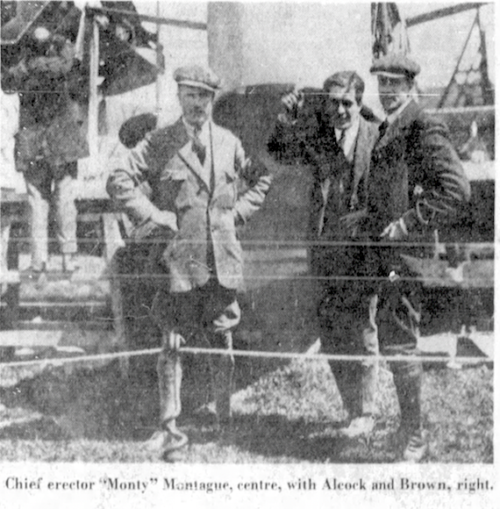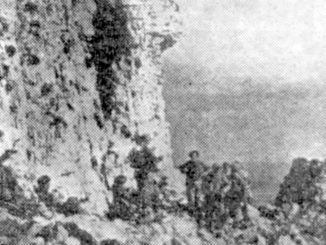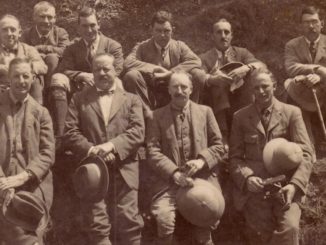In May 1969 my uncle, John Alldridge, described the voyage of Allcock and Brown for the Montreal Star. This is the third of his reports. – Jerry F

John Alldridge recalls the epic flight of Alcock and Brown,
Montreal Star – Newspapers.com, reproduced with permission
When John Alcock was released from his Turkish prison camp at the end of the war and returned to Manchester he found the British aircraft industry in a state of chaos.
In a few years a whole new industry had grown up out of the humble workshop of 1914. The sudden switch over from war to peace had begun a feverish activity between competing aircraft firms; each of whom knew that in order to stay in business it must keep ahead of the field. Prestige was everything.
The Daily Mail’s £10,000 prize for the first non-stop Atlantic flight, offered as long ago as 1913, was still unwon. And what better prestige could there have been than to build the aeroplane that would make that flight and win that prize?
Plans were made in secret. But by the end of 1918 the British public knew that there were at least 11 entries in the race to be first across.
All agreed, with one exception, that the flight should be made from west to east, to take advantage of prevailing westerly winds.
According to the terms of the Daily Mail award the flight had to be made in one stage. And the shortest possible distance was the great circle route of 1,880 miles between Newfoundland and Ireland.
On November 14, 1918, the Royal Aero Club announced that the wartime veto on Atlantic flying had been lifted. And the race was on.
Of the original entry only four were destined to reach Newfoundland.
First in the field was the Sopwith Company with a two-seater biplane powered by a single Rolls Royce Eagle engine, which they had optimistically christened Atlantic.
By comparison with the big bombers of the day the Atlantic was a relatively small aircraft; but it could carry enough gasoline and oil for a flight of 30 hours, at an average speed of 100 miles an hour.
It would be piloted by the Australian Harry Hawker, generally acknowledged to be the most brilliant flier in Britain. For his navigator he had Lieut. Commander Mackenzie-Grieve. During the war he had gained valuable experience as navigating officer aboard the sea-plane tender Campania.
Hawker’s nearest rival was expected to be his old friend Freddie Raynham, flying the Martinside Company’s Raymor; a two-seater biplane powered by a single Rolls Royce Falcon engine. It carried sufficient gasoline for a flight of 25 hours at 110 mph, and was considered faster than the Atlantic.
Raynham’s navigator — Capt. C. W. F. Morgan — was also borrowed from the Navy.
The largest entry was the Handley Page giant bomber V-1500. It was powered by four Rolls Royce Eagle engines mounted in tandem, and carried a crew of six. It had been originally designed towards the end of the war to bomb Berlin from bases in Britain.
The pilot was Major H. G. Brackley — the same Brackley who had been taught to fly by Alcock at Eastchurch. His navigator was a Norwegian, Trygve Gran, who had much experience of long-distance flying.
There was also an unofficial entry from the United States, who proposed to send a flight of three Navy Curtiss seaplanes by way of the Azores.
Last to arrive — so late that it was almost a non-starter — was the Vickers Vimy, a standard bomber powered by two specially fitted Rolls Royce Eagle engines and piloted by John Alcock.
Actually had it not been for Alcock’s passionate enthusiasm it is unlikely that the Vimy would ever have taken part in the race.
On the day after he was demobilized Alcock visited the Vickers works at Weybridge to meet two old friends from his Brooklands days — Charles Knight, the aviation superintendent and Maxwell Muller, the works manager. On the way down in the train he had read that Vickers, who for some time toyed with the idea of entering, had finally decided to withdraw for lack of a suitable pilot.
For two weary years in his prison camp Alcock had dreamed of nothing else but flying the Atlantic. His burning enthusiasm and unflagging arguments quickly won over Muller and Knight. Within half an hour of Alcock’s arrival the Vickers Vimy was a firm entry with Alcock as her pilot.
The work of modifying the one-time bomber — she was one of only 12 of her class to be built — then began under the unremitting eye of Alcock and the plane’s young designer, Rex Pierson.
Actually the modifications were surprisingly few. They combined two individual cockpits into one so that pilot and navigator could sit side by side. They replaced the nose skid with wheels; and where the bombing gear and bomb bays had been they found room for the extra fuel tanks, one of which had to serve as a buoyant raft in case of a forced landing in the sea.
While this work was going on — and while Alcock was in Derby at Rolls Royce, watching the special Mark 8 engines being run in – Brown, who had recently joined the team, was borrowing compass and radio equipment from the Air Ministry and a Mercator’s chart and standard naval navigational gear from the Admiralty.
On April 18, 1919, the Vimy was lined up for her first test flight. With Alcock at the controls she behaved beautifully and continued to do so throughout subsequent flights when all the equipment was thoroughly tested. Now she was ready to be shipped to Newfoundland. And on May 4 Alcock and Brown sailed from Southampton for Halifax on the Mauritania.
With them went a hand-picked team of three experts: Frank Pitman, the foreman, Bob Dicker, in charge of flying control, and an old chum of Alcock’s from the Brooklands days, and “Monty” Montague, the head erector, from Liverpool. The Vimy with her mechanics would follow on the freighter Glendevon.

Chief erector ‘Monty’ Montague,centre, with Alcock and Brown, right,
Montreal Star – Newspapers.com, reproduced with permission
They were only just in time. Over in Newfoundland Hawker and Raynham, their aircraft ready for the take-off, were only waiting for the first favourable break in the weather …
NEXT: Gallant failures leave only two planes in the race.
Reproduced with permission
© 2022 Newspapers.com
Jerry F 2023



